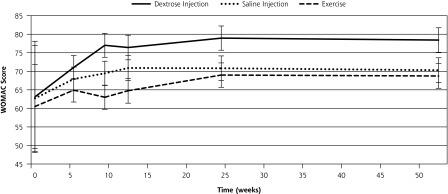Are you tired of living with persistent pain caused by musculoskeletal conditions? Have you explored various treatment options without finding lasting relief?
If so, it’s time for prolotherapy – an alternative treatment that harnesses the body’s innate healing abilities to alleviate pain and restore quality of life.
In this article, we’ll delve into prolotherapy and discover why it might be the solution you’ve been searching for.
Harnessing Your Body’s Power to Repair and Recover With Prolotherapy
What is Prolotherapy?
Prolotherapy, short for proliferative therapy, is a groundbreaking medical approach that aims to jumpstart the body’s natural healing mechanisms by stimulating tissue growth and repair.
Unlike conventional treatments that merely manage symptoms, prolotherapy addresses the root cause of pain – damaged or weakened ligaments, tendons, and connective tissues – making it an increasingly popular choice for individuals seeking a long-lasting solution.
How Does Prolotherapy Work?
At the core of prolotherapy are targeted injections (intra-articular or extra-articular) of an irritant solution containing dextrose (a form of sugar) at 10% to 25% concentration.
While the term “irritant” might sound intimidating, this solution is carefully calibrated to trigger a controlled inflammatory response in the affected area. This controlled inflammation serves as a catalyst for the body’s natural repair processes (proliferation).
When the irritant solution is injected into the damaged tissue, it prompts the body to send healing cells and growth factors to the area, kickstarting the regeneration of ligaments, tendons, and other connective tissues.
Prolotherapy injections strengthen these structures (remodeling) and improve their function, effectively relieving pain at its source. Patients often experience significant pain relief and increased mobility as the body heals and repairs itself.

What Are Prolotherapy Benefits?
Prolotherapy offers a range of compelling benefits that set it apart from traditional pain management techniques:
- Long-lasting Pain Relief: Unlike pain medications that provide temporary relief, prolotherapy addresses the underlying cause of pain. By encouraging the body to heal, prolotherapy provides lasting results beyond the treatment period.
- Non-Invasive Alternative: Invasive surgeries can be daunting and involve lengthy recovery periods. Prolotherapy presents a non-invasive alternative that doesn’t require incisions, anesthesia, or hospital stays. This advantage minimizes the associated risks and downtime, allowing you to resume your daily activities sooner.
- Tailored to Your Needs: Prolotherapy is not a one-size-fits-all approach. Each treatment session can be customized to target specific areas of pain, ensuring that the therapy addresses your unique needs and concerns.
- Minimal Side Effects: Prolotherapy side effects are typically mild and short-lived. Patients may experience some soreness at the injection site, but this discomfort pales to the pain they seek to alleviate.
- Holistic Healing: Prolotherapy promotes holistic recovery rather than simply masking pain. By fortifying your body’s repair mechanisms, prolotherapy empowers you to take charge of your health and well-being.
Prolotherapy for Knee Osteoarthritis
A 2013 study published in the Annals of Family Medicine shed light on the remarkable benefits of prolotherapy for knee osteoarthritis.
This study involved 90 patients suffering from painful knee osteoarthritis for at least 3 months. Over 17 weeks, these patients received dextrose prolotherapy knee injections, followed by a 52-week follow-up period. The results were astounding.
Compared to patients who received a placebo (saline) or engaged in exercise alone, those on dextrose prolotherapy experienced significantly improved WOMAC scores. This validated questionnaire assesses osteoarthritis severity based on pain, stiffness, and function.
The improvement in scores for the prolotherapy group was striking, with a difference of 15.3 points compared to 7.6 and 8.2 points for the placebo and exercise groups, respectively.
Patient satisfaction with prolotherapy was notably high, underscoring its effectiveness in providing relief. The study also highlighted the safety and tolerance of prolotherapy, as no adverse events were reported during treatment.
This research reveals prolotherapy’s ability to provide a promising avenue for effective, safe, and lasting relief. The fact that prolotherapy outperformed placebo and exercise underscores its potential as an alternative solution for individuals grappling with knee osteoarthritis.

Prolotherapy Vs. PRP: Which is Better?
According to a review published in the Journal of Clinical Orthopaedics and Trauma (JCOT), 2 studies compared the effectiveness of prolotherapy and Platelet-rich plasma (PRP) therapy for knee osteoarthritis.
In one study with a 6-month follow-up, combined intra-articular and periarticular dextrose prolotherapy displayed no superiority over PRP. The WOMAC scores for pain, stiffness, and function remained similar throughout all time points in prolotherapy.
In another study investigating intra-articular dextrose prolotherapy and PRP, prolotherapy didn’t significantly alter pain or WOMAC scores at 1 month and 6 months after treatment. On the other hand, PRP reduced pain at 1 month but not at 6 months.
When pooling the results of 2 studies involving 82 participants, PRP showed a significant advantage in WOMAC function and stiffness subscales.
These findings suggest that while prolotherapy and PRP have their respective merits, PRP offers a slight advantage regarding stiffness subscale improvement.
Who is Prolotherapy Suitable for?
Whether you’re dealing with osteoarthritis, ligament or tendon injuries, or joint pain, prolotherapy could offer the relief you’ve been searching for. It’s appealing to those who prefer non-invasive treatments that stimulate the body’s natural healing processes.
What Are the Risks of Prolotherapy?
One of the most compelling aspects of prolotherapy is its low-risk profile. Unlike surgical interventions with potential risks and complications, prolotherapy is minimally invasive.
The most common side effects are mild soreness and discomfort at the injection site, which typically subside within a short period. Serious complications are rare, making prolotherapy a safer alternative for pain management than more invasive options.
Does Prolotherapy Require Recovery Time?

Unlike several surgeries for pain management that demand weeks or even months of downtime, prolotherapy requires little to no recovery time. The procedure is brief; you can resume your normal activities immediately after the session.
This advantage means you can undergo prolotherapy without significant interruptions to your daily life, allowing you to regain your quality of life sooner.
How Much Does Prolotherapy Cost?
The cost of prolotherapy can vary depending on several factors, including your location, the extent of treatment needed, and your preferred healthcare provider. Generally, the cost is an out-of-pocket expense, and the total amount can add up over multiple sessions.
On average, prolotherapy sessions can range from hundreds of dollars per session.
Is Prolotherapy Covered by Insurance?
Prolotherapy is still considered a novel approach and may not be recognized as a standard procedure by insurance providers. As a result, individuals who choose prolotherapy should be prepared to cover the entire cost out of pocket.
While this can be a financial consideration, many find that the long-term benefits of pain relief and improved quality of life outweigh the upfront costs.
Bottom Line
Prolotherapy is a powerful and effective alternative treatment for individuals battling chronic pain due to musculoskeletal conditions. Through targeted prolotherapy injections and the utilization of irritant solutions like dextrose, this therapy stimulates the body’s natural healing responses, facilitating tissue regeneration and pain reduction.
If you’re tired of living with pain and are ready to embrace a treatment that works with your body, prolotherapy could be your key to unlocking a pain-free future.
References
Rabago D et al. (2013). Dextrose Prolotherapy for Knee Osteoarthritis: A Randomized Controlled Trial. Annals of Family Medicine
Wee T et al. (2021). Dextrose Prolotherapy in Knee Osteoarthritis: A Systematic Review and Meta-analysis. Journal of Clinical Orthopaedics and Trauma.

